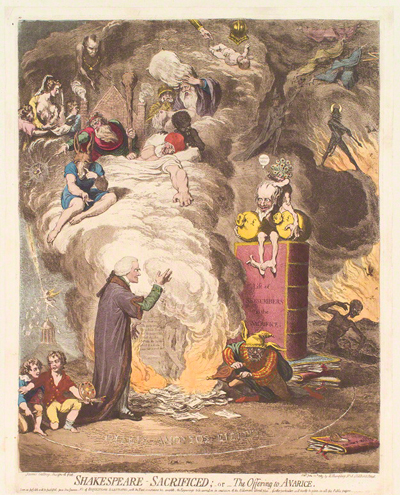Shakespeare Sacrific'd
There are at least two major targets in Gillray's Shakespeare Sacrific'd: the first is the publisher, John Boydell and the second, the Royal Academy.
In 1786, Boydell and a group of friends came up with the idea of an illustrated edition of Shakespeare. Boydell commissioned many of the best-known artists working in England at the time to paint scenes from Shakespeare which would then be shown at a special Shakespeare Gallery in London. Artists included James Barry, Henry Fuseli, Angelica Kauffman, James Northcote, John Opie, Joshua Reynolds, George Romney, Benjamin West, and others. Engravings, based on the paintings, were also commissioned to be included in the edition of Shakespeare, in a collected folio of prints, and sold separately as individual prints.
Boydell had high hopes for the venture. As a promoter of the arts, he hoped that it would stimulate a new school of British history painting, based appropriately enough on Britain's greatest playwright. As a businessman, however, he also saw an opportunity for several sources of revenue: from attendance at the gallery, from subscriptions to the edition of Shakespeare, from the sale of a folio collection of the prints, and from the sale of individual prints.

© National Portrait Gallery, London
Gillray, however, saw the whole effort as a monumental mistake, a deal with the devil that obscured Shakespeare's true significance, and foolishly sacrificed his plays to the interests of fame and greed. Indeed, the venture did ultimately fail, and Boydell was nearly bankrupted by it.
Gillray's other target is the Royal Academy with its privileged membership which allowed a select group of painters to show their works at the Great Exhibition Hall but refused that privilege to engravers. Around the hall was the Greek text that is seen in the magic circle at Boydell's feet. It can be translated as "Let no stranger to the muses enter here." A young boy with a painter's palette who kneels safely within the circle pushes away another boy with an engraver's burin. Both, however, are strikingly poor and ragged compared with the richly robed Alderman Boydell.
The print includes figures from various Shakespearean scenes, most of which have identifiable sources among the paintings and engravings commissioned by Boydell.
- Top left is Richard III from James Northcote's painting of Act III, Scene 1 of King Richard III.
- Top center is the baby Perdita from John Opie's painting of Act II, Scene 3 of The Winter's Tale.
- Top right are the three witches from Fuseli's painting of Act 1, Scene 3 of Macbeth.
- Upper left, just below Richard, is Edward's Queen Elizabeth and her babe from Northcote's painting of Henry VI Pt 3, Act V. Scene VII, engraved by J. B. Michel.
- Next to Queen Elizabeth is King Lear sitting on a throne with arm outstretched based on Fuseli's picture of the banishment of Cordelia from Act I, Scene 2 of King Lear.
- Next to that image of Lear and slightly above is another scene from Lear: this one from James Barry's painting of King Lear Weeping over the Dead Body of Cordelia [1786-88]
- Just below is the dying Cardinal Beaufort from Joshua Reynold's painting, the Death of Cardinal Beaufort.
- To the right of Beaufort and above the image of Avarice is Richard Plantagenet from Boydell's painting of Act II, Scene 4 of Henry VI Pt 1.
- Above and to the right of Avarice is a demon based Fuseli's painting of the Ghost of Hamlet's Father.
- At left above the figure of Alderman Boydell, appears the weaver, Bottom transformed into an ass from Henry Fuseli's painting of Titania and Bottom [1790]
- Below the large book labeled the List of Subscribers to the Sacrifice is the Fool from Benjamin West's painting of King Lear on the Heath [1788].
Most of the scenes from Shakespeare seem to have been chosen because like the Boydell venture itself, they represent moments of decisive and irreparable mistakes in judgement. But they also illustrate Gillray's abilities as an artist and printmaker to arrange a wide variety of figures across an inventive and coherent visual space using a full suite of printmaking techniques.
Sources and Reading
- Commentary from the British Museum on Shakespeare Sacrific'd
- Goldmark Gallery, "Shakespeare Sacrificed" (Video)
- Draper Hill, Mr. Gillray The Caricaturist, 1965
- "Boydell Shakespeare Gallery," Wikipedia
- Thomas Wright and R.H. Evans, Historical and Descriptive Account of the Caricatures of James Gillray #380
Comments & Corrections
NOTE: Comments and/or corrections are always appreciated. To make that easier, I have included a form below that you can use. I promise never to share any of the info provided without your express permission.